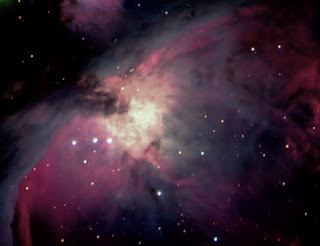Physics Photo of the Week

Physics Photo of the Week March 22, 2024 M42 - The Great Nebula in Orion - Astrophotos by College View Observatory The Orion Nebula - Messier 42 - is the brightest nebulous object in the sky - even visible with the naked eye in dark skies. If this looks like a large cosmic cloud lit up from the inside - that's exactly what it is! This cloud is in the Milky Way galaxy - "only" about 1300 light years distant. This nebula is relatively close. The closest external galaxy is about 2 Million light years distant - over 1000 times further away. The colors and the large angular size (greater than one degree) make the Orion Nebula one of the most beautiful and interesting cosmic objects! The interior light for illuminating this gigantic cosmic cloud is a nursery of "baby" stars in the middle of it. However the "baby" stars are not "innocent". They are some of the hottest stars known in the cosmos as well as some of the largest.* The photo at...
